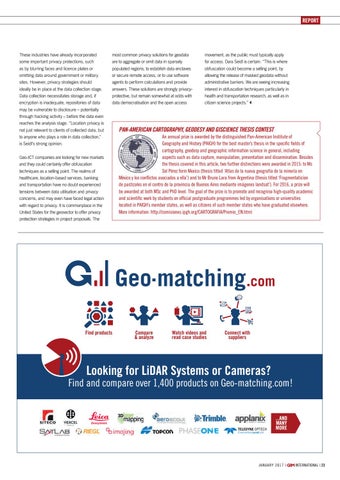Report
These industries have already incorporated some important privacy protections, such as by blurring faces and licence plates or omitting data around government or military sites. However, privacy strategies should ideally be in place at the data collection stage. Data collection necessitates storage and, if encryption is inadequate, repositories of data may be vulnerable to disclosure – potentially through hacking activity – before the data even reaches the analysis stage. “Location privacy is not just relevant to clients of collected data, but to anyone who plays a role in data collection,” is Seidl’s strong opinion.
most common privacy solutions for geodata are to aggregate or omit data in sparsely populated regions, to establish data enclaves or secure remote access, or to use software agents to perform calculations and provide answers. These solutions are strongly privacyprotective, but remain somewhat at odds with data democratisation and the open access
Geo-ICT companies are looking for new markets and they could certainly offer obfuscation techniques as a selling point. The realms of healthcare, location-based services, banking and transportation have no doubt experienced tensions between data utilisation and privacy concerns, and may even have faced legal action with regard to privacy. It is commonplace in the United States for the geosector to offer privacy protection strategies in project proposals. The
Find products
movement, as the public must typically apply for access. Dara Seidl is certain: “This is where obfuscation could become a selling point, by allowing the release of masked geodata without administrative barriers. We are seeing increasing interest in obfuscation techniques particularly in health and transportation research, as well as in citizen science projects.”
Pan-American Cartography, Geodesy and GIScience Thesis Contest An annual prize is awarded by the distinguished Pan-American Institute of Geography and History (PAIGH) for the best master’s thesis in the specific fields of cartography, geodesy and geographic information science in general, including aspects such as data capture, manipulation, presentation and dissemination. Besides the thesis covered in this article, two further distinctions were awarded in 2015: to Ms Sol Pérez form Mexico (thesis titled ‘Atlas de la nueva geografía de la minería en México y los conflictos asociados a ella’) and to Mr Bruno Lara from Argentina (thesis titled ‘Fragmentaticíon de pastizales en el centro de la provincia de Buenos Aires mediante imágenes landsat’). For 2016, a prize will be awarded at both MSc and PhD level. The goal of the prize is to promote and recognise high-quality academic and scientific work by students on official postgraduate programmes led by organisations or universities located in PAIGH’s member states, as well as citizens of such member states who have graduated elsewhere. More information: http://comisiones.ipgh.org/CARTOGRAFIA/Premio_EN.html
Compare & analyze
Watch videos and read case studies
Connect with suppliers
Looking for LiDAR Systems or Cameras?
Find and compare over 1,400 products on Geo-matching.com! ...AND MANY MORE
january 2 0 1 7 |
21-22-23_reportseidl.indd 23
international | 23
06-01-17 11:37
